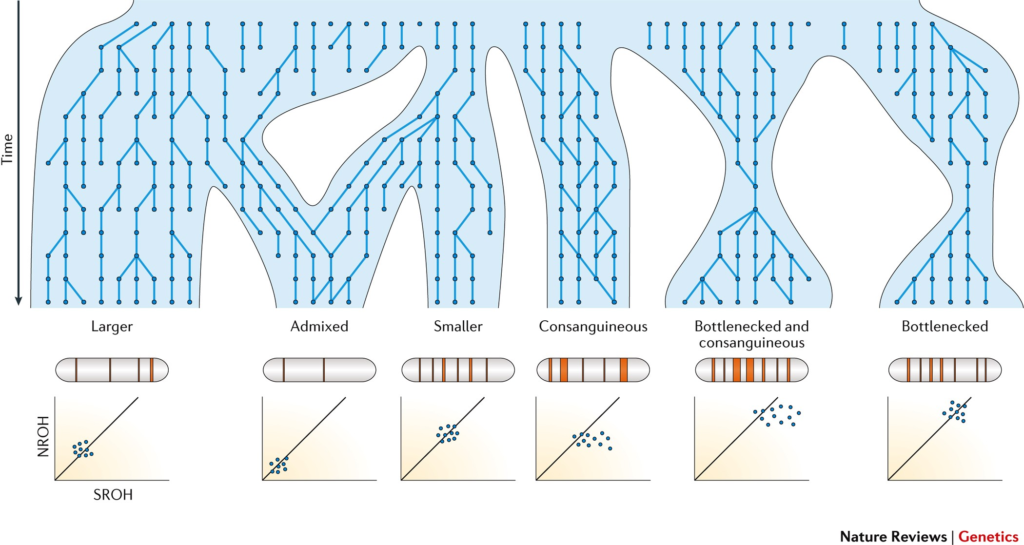La consanguinidad es el grado de relación de sangre entre dos personas (parentesco). Hay diversos grados de consanguinidad. Es un factor de riesgo de enfermedades genéticas, en particular las autosómico recesivas (¿cuando sospechar una metabolopatía , sobretodo, aquellas que tienen tratamiento curativo ?).
Coeficiente de consanguinidad.
Existe un coeficiente de endogamia (coefficient of inbreeding and coefficient of relationship ), que permite calcular la probabilidad de homocigosis en función de la ascendencia, o inferir la presencia de consanguinidad a partir del grado de homocigosis, que puede ser identificado en los SNP arrays (runs of homocigosity). Esto puede dar lugar al desenmascaramiento de relaciones incestuosas y de abuso.
332710
{332710:RMJQWURU}
vancouver
50
6305
https://neuropediatoolkit.org/wp-content/plugins/zotpress/
%7B%22status%22%3A%22success%22%2C%22updateneeded%22%3Afalse%2C%22instance%22%3A%22zotpress-db6a0c0d1269db77f108b93b8c59aa99%22%2C%22meta%22%3A%7B%22request_last%22%3A0%2C%22request_next%22%3A0%2C%22used_cache%22%3Atrue%7D%2C%22data%22%3A%5B%7B%22key%22%3A%22RMJQWURU%22%2C%22library%22%3A%7B%22id%22%3A332710%7D%2C%22meta%22%3A%7B%22creatorSummary%22%3A%22Schaaf%20et%20al.%22%2C%22parsedDate%22%3A%222011%22%2C%22numChildren%22%3A1%7D%2C%22bib%22%3A%22%3Cdiv%20class%3D%5C%22csl-bib-body%5C%22%20style%3D%5C%22line-height%3A%201.35%3B%20%5C%22%3E%5Cn%20%20%3Cdiv%20class%3D%5C%22csl-entry%5C%22%20style%3D%5C%22clear%3A%20left%3B%20%5C%22%3E%5Cn%20%20%20%20%3Cdiv%20class%3D%5C%22csl-left-margin%5C%22%20style%3D%5C%22float%3A%20left%3B%20padding-right%3A%200.5em%3B%20text-align%3A%20right%3B%20width%3A%201em%3B%5C%22%3E1.%3C%5C%2Fdiv%3E%3Cdiv%20class%3D%5C%22csl-right-inline%5C%22%20style%3D%5C%22margin%3A%200%20.4em%200%201.5em%3B%5C%22%3ESchaaf%20C%2C%20Scott%20D%2C%20Wiszniewska%20J%2C%20Beaudet%20A.%20Identification%20of%20incestuous%20parental%20relationships%20by%20SNP-based%20DNA%20microarrays.%20The%20Lancet%20%5BInternet%5D.%202011%20%5Bcited%202021%20Apr%2018%5D%3B377%289765%29%3A555%26%23x2013%3B6.%20Available%20from%3A%20%3Ca%20href%3D%27https%3A%5C%2F%5C%2Flinkinghub.elsevier.com%5C%2Fretrieve%5C%2Fpii%5C%2FS0140673611602018%27%3Ehttps%3A%5C%2F%5C%2Flinkinghub.elsevier.com%5C%2Fretrieve%5C%2Fpii%5C%2FS0140673611602018%3C%5C%2Fa%3E%3C%5C%2Fdiv%3E%5Cn%20%20%3C%5C%2Fdiv%3E%5Cn%3C%5C%2Fdiv%3E%22%2C%22data%22%3A%7B%22itemType%22%3A%22journalArticle%22%2C%22title%22%3A%22Identification%20of%20incestuous%20parental%20relationships%20by%20SNP-based%20DNA%20microarrays%22%2C%22creators%22%3A%5B%7B%22creatorType%22%3A%22author%22%2C%22firstName%22%3A%22Cp%22%2C%22lastName%22%3A%22Schaaf%22%7D%2C%7B%22creatorType%22%3A%22author%22%2C%22firstName%22%3A%22Da%22%2C%22lastName%22%3A%22Scott%22%7D%2C%7B%22creatorType%22%3A%22author%22%2C%22firstName%22%3A%22J%22%2C%22lastName%22%3A%22Wiszniewska%22%7D%2C%7B%22creatorType%22%3A%22author%22%2C%22firstName%22%3A%22Al%22%2C%22lastName%22%3A%22Beaudet%22%7D%5D%2C%22abstractNote%22%3A%22%22%2C%22date%22%3A%2202%5C%2F2011%22%2C%22language%22%3A%22en%22%2C%22DOI%22%3A%2210.1016%5C%2FS0140-6736%2811%2960201-8%22%2C%22ISSN%22%3A%2201406736%22%2C%22url%22%3A%22https%3A%5C%2F%5C%2Flinkinghub.elsevier.com%5C%2Fretrieve%5C%2Fpii%5C%2FS0140673611602018%22%2C%22collections%22%3A%5B%22RNVDAQWR%22%5D%2C%22dateModified%22%3A%222021-04-18T12%3A12%3A28Z%22%7D%7D%5D%7D
Paises con más consanguinidad.
La consanguinidad es mayor en aquellos países que practican la endogamia . El resultado es un aumento de la homocigosis, y como consecuencia, la mayor prevalencia de enfermedades autosómico recesivas .
Los tramos de homocigosidad (regions of homocigosity, ROH) son el resultado genético de la consanguinidad, y pueden ser estudiados mediante técnicas genéticas como el array de SNP. El coeficiente de endogamia se correlaciona directamente con la cantidad de tramos de homocigosidad de un genoma.
332710
{332710:9I8NM9QI}
vancouver
50
6305
https://neuropediatoolkit.org/wp-content/plugins/zotpress/
%7B%22status%22%3A%22success%22%2C%22updateneeded%22%3Afalse%2C%22instance%22%3A%22zotpress-dbc5f7e3e43d75c89d80e48e3f732d2c%22%2C%22meta%22%3A%7B%22request_last%22%3A0%2C%22request_next%22%3A0%2C%22used_cache%22%3Atrue%7D%2C%22data%22%3A%5B%7B%22key%22%3A%229I8NM9QI%22%2C%22library%22%3A%7B%22id%22%3A332710%7D%2C%22meta%22%3A%7B%22creatorSummary%22%3A%22Sund%20et%20al.%22%2C%22parsedDate%22%3A%222013%22%2C%22numChildren%22%3A5%7D%2C%22bib%22%3A%22%3Cdiv%20class%3D%5C%22csl-bib-body%5C%22%20style%3D%5C%22line-height%3A%201.35%3B%20%5C%22%3E%5Cn%20%20%3Cdiv%20class%3D%5C%22csl-entry%5C%22%20style%3D%5C%22clear%3A%20left%3B%20%5C%22%3E%5Cn%20%20%20%20%3Cdiv%20class%3D%5C%22csl-left-margin%5C%22%20style%3D%5C%22float%3A%20left%3B%20padding-right%3A%200.5em%3B%20text-align%3A%20right%3B%20width%3A%201em%3B%5C%22%3E1.%3C%5C%2Fdiv%3E%3Cdiv%20class%3D%5C%22csl-right-inline%5C%22%20style%3D%5C%22margin%3A%200%20.4em%200%201.5em%3B%5C%22%3ESund%20KL%2C%20Zimmerman%20SL%2C%20Thomas%20C%2C%20Mitchell%20AL%2C%20Prada%20CE%2C%20Grote%20L%2C%20et%20al.%20Regions%20of%20homozygosity%20identified%20by%20SNP%20microarray%20analysis%20aid%20in%20the%20diagnosis%20of%20autosomal%20recessive%20disease%20and%20incidentally%20detect%20parental%20blood%20relationships.%20Genet%20Med%20%5BInternet%5D.%202013%20Enero%20%5Bcited%202016%20Sep%2029%5D%3B15%281%29%3A70%26%23x2013%3B8.%20Available%20from%3A%20%3Ca%20href%3D%27http%3A%5C%2F%5C%2Fwww.nature.com%5C%2Fgim%5C%2Fjournal%5C%2Fv15%5C%2Fn1%5C%2Ffull%5C%2Fgim201294a.html%27%3Ehttp%3A%5C%2F%5C%2Fwww.nature.com%5C%2Fgim%5C%2Fjournal%5C%2Fv15%5C%2Fn1%5C%2Ffull%5C%2Fgim201294a.html%3C%5C%2Fa%3E%3C%5C%2Fdiv%3E%5Cn%20%20%3C%5C%2Fdiv%3E%5Cn%3C%5C%2Fdiv%3E%22%2C%22data%22%3A%7B%22itemType%22%3A%22journalArticle%22%2C%22title%22%3A%22Regions%20of%20homozygosity%20identified%20by%20SNP%20microarray%20analysis%20aid%20in%20the%20diagnosis%20of%20autosomal%20recessive%20disease%20and%20incidentally%20detect%20parental%20blood%20relationships%22%2C%22creators%22%3A%5B%7B%22creatorType%22%3A%22author%22%2C%22firstName%22%3A%22Kristen%20Lipscomb%22%2C%22lastName%22%3A%22Sund%22%7D%2C%7B%22creatorType%22%3A%22author%22%2C%22firstName%22%3A%22Sarah%20L.%22%2C%22lastName%22%3A%22Zimmerman%22%7D%2C%7B%22creatorType%22%3A%22author%22%2C%22firstName%22%3A%22Cameron%22%2C%22lastName%22%3A%22Thomas%22%7D%2C%7B%22creatorType%22%3A%22author%22%2C%22firstName%22%3A%22Anna%20L.%22%2C%22lastName%22%3A%22Mitchell%22%7D%2C%7B%22creatorType%22%3A%22author%22%2C%22firstName%22%3A%22Carlos%20E.%22%2C%22lastName%22%3A%22Prada%22%7D%2C%7B%22creatorType%22%3A%22author%22%2C%22firstName%22%3A%22Lauren%22%2C%22lastName%22%3A%22Grote%22%7D%2C%7B%22creatorType%22%3A%22author%22%2C%22firstName%22%3A%22Liming%22%2C%22lastName%22%3A%22Bao%22%7D%2C%7B%22creatorType%22%3A%22author%22%2C%22firstName%22%3A%22Lisa%20J.%22%2C%22lastName%22%3A%22Martin%22%7D%2C%7B%22creatorType%22%3A%22author%22%2C%22firstName%22%3A%22Teresa%20A.%22%2C%22lastName%22%3A%22Smolarek%22%7D%5D%2C%22abstractNote%22%3A%22The%20purpose%20of%20this%20study%20was%20to%20document%20the%20ability%20of%20single-nucleotide%20polymorphism%20microarray%20to%20identify%20copy-neutral%20regions%20of%20homozygosity%2C%20demonstrate%20clinical%20utility%20of%20regions%20of%20homozygosity%2C%20and%20discuss%20ethical%5C%2Flegal%20implications%20when%20regions%20of%20homozygosity%20are%20associated%20with%20a%20parental%20blood%20relationship.%5CnStudy%20data%20were%20compiled%20from%20consecutive%20samples%20sent%20to%20our%20clinical%20laboratory%20over%20a%203-year%20period.%20A%20cytogenetics%20database%20identified%20patients%20with%20at%20least%20two%20regions%20of%20homozygosity%20%3E10%20Mb%20on%20two%20separate%20chromosomes.%20A%20chart%20review%20was%20conducted%20on%20patients%20who%20met%20the%20criteria.%5CnOf%203%2C217%20single-nucleotide%20polymorphism%20microarrays%2C%2059%20%281.8%25%29%20patients%20met%20inclusion%20criteria.%20The%20percentage%20of%20homozygosity%20ranged%20from%200.9%20to%2030.1%25%2C%20indicating%20parental%20relationships%20from%20distant%20to%20first-degree%20relatives.%20First-degree%20kinship%20was%20suspected%20in%20the%20parents%20of%20at%20least%2011%20patients%20with%20regions%20of%20homozygosity%20covering%20%3E21.3%25%20of%20their%20autosome.%20In%20four%20patients%20from%20two%20families%2C%20homozygosity%20mapping%20discovered%20a%20candidate%20gene%20that%20was%20sequenced%20to%20identify%20a%20clinically%20significant%20mutation.%5CnThis%20study%20demonstrates%20clinical%20utility%20in%20the%20identification%20of%20regions%20of%20homozygosity%2C%20as%20these%20regions%20may%20aid%20in%20diagnosis%20of%20the%20patient.%20This%20study%20establishes%20the%20need%20for%20careful%20reporting%2C%20thorough%20pretest%20counseling%2C%20and%20careful%20electronic%20documentation%2C%20as%20microarray%20has%20the%20capability%20of%20detecting%20previously%20unknown%5C%2Funreported%20relationships.%5CnGenet%20Med%202013%3A15%281%29%3A70%5Cu201378%22%2C%22date%22%3A%22Enero%202013%22%2C%22language%22%3A%22en%22%2C%22DOI%22%3A%2210.1038%5C%2Fgim.2012.94%22%2C%22ISSN%22%3A%221098-3600%22%2C%22url%22%3A%22http%3A%5C%2F%5C%2Fwww.nature.com%5C%2Fgim%5C%2Fjournal%5C%2Fv15%5C%2Fn1%5C%2Ffull%5C%2Fgim201294a.html%22%2C%22collections%22%3A%5B%22RNVDAQWR%22%2C%22VHZRHN58%22%5D%2C%22dateModified%22%3A%222023-02-20T18%3A50%3A01Z%22%7D%7D%5D%7D
1.
Sund KL, Zimmerman SL, Thomas C, Mitchell AL, Prada CE, Grote L, et al. Regions of homozygosity identified by SNP microarray analysis aid in the diagnosis of autosomal recessive disease and incidentally detect parental blood relationships. Genet Med [Internet]. 2013 Enero [cited 2016 Sep 29];15(1):70–8. Available from:
http://www.nature.com/gim/journal/v15/n1/full/gim201294a.html
Consanguinidad en las familias reales europeas.
332710
{332710:7CVSXTVF}
vancouver
50
6305
https://neuropediatoolkit.org/wp-content/plugins/zotpress/
%7B%22status%22%3A%22success%22%2C%22updateneeded%22%3Afalse%2C%22instance%22%3A%22zotpress-fc3c2db3467c00302ce4bfe4980d8b87%22%2C%22meta%22%3A%7B%22request_last%22%3A0%2C%22request_next%22%3A0%2C%22used_cache%22%3Atrue%7D%2C%22data%22%3A%5B%7B%22key%22%3A%227CVSXTVF%22%2C%22library%22%3A%7B%22id%22%3A332710%7D%2C%22meta%22%3A%7B%22creatorSummary%22%3A%22Alvarez%20et%20al.%22%2C%22parsedDate%22%3A%222009-04-15%22%2C%22numChildren%22%3A3%7D%2C%22bib%22%3A%22%3Cdiv%20class%3D%5C%22csl-bib-body%5C%22%20style%3D%5C%22line-height%3A%201.35%3B%20%5C%22%3E%5Cn%20%20%3Cdiv%20class%3D%5C%22csl-entry%5C%22%20style%3D%5C%22clear%3A%20left%3B%20%5C%22%3E%5Cn%20%20%20%20%3Cdiv%20class%3D%5C%22csl-left-margin%5C%22%20style%3D%5C%22float%3A%20left%3B%20padding-right%3A%200.5em%3B%20text-align%3A%20right%3B%20width%3A%201em%3B%5C%22%3E1.%3C%5C%2Fdiv%3E%3Cdiv%20class%3D%5C%22csl-right-inline%5C%22%20style%3D%5C%22margin%3A%200%20.4em%200%201.5em%3B%5C%22%3EAlvarez%20G%2C%20Ceballos%20FC%2C%20Quinteiro%20C.%20The%20Role%20of%20Inbreeding%20in%20the%20Extinction%20of%20a%20European%20Royal%20Dynasty.%20PLoS%20One%20%5BInternet%5D.%202009%20Apr%2015%20%5Bcited%202023%20Jul%2017%5D%3B4%284%29%3Ae5174.%20Available%20from%3A%20%3Ca%20href%3D%27https%3A%5C%2F%5C%2Fwww.ncbi.nlm.nih.gov%5C%2Fpmc%5C%2Farticles%5C%2FPMC2664480%5C%2F%27%3Ehttps%3A%5C%2F%5C%2Fwww.ncbi.nlm.nih.gov%5C%2Fpmc%5C%2Farticles%5C%2FPMC2664480%5C%2F%3C%5C%2Fa%3E%3C%5C%2Fdiv%3E%5Cn%20%20%3C%5C%2Fdiv%3E%5Cn%3C%5C%2Fdiv%3E%22%2C%22data%22%3A%7B%22itemType%22%3A%22journalArticle%22%2C%22title%22%3A%22The%20Role%20of%20Inbreeding%20in%20the%20Extinction%20of%20a%20European%20Royal%20Dynasty%22%2C%22creators%22%3A%5B%7B%22creatorType%22%3A%22author%22%2C%22firstName%22%3A%22Gonzalo%22%2C%22lastName%22%3A%22Alvarez%22%7D%2C%7B%22creatorType%22%3A%22author%22%2C%22firstName%22%3A%22Francisco%20C.%22%2C%22lastName%22%3A%22Ceballos%22%7D%2C%7B%22creatorType%22%3A%22author%22%2C%22firstName%22%3A%22Celsa%22%2C%22lastName%22%3A%22Quinteiro%22%7D%5D%2C%22abstractNote%22%3A%22The%20kings%20of%20the%20Spanish%20Habsburg%20dynasty%20%281516%5Cu20131700%29%20frequently%20married%20close%20relatives%20in%20such%20a%20way%20that%20uncle-niece%2C%20first%20cousins%20and%20other%20consanguineous%20unions%20were%20prevalent%20in%20that%20dynasty.%20In%20the%20historical%20literature%2C%20it%20has%20been%20suggested%20that%20inbreeding%20was%20a%20major%20cause%20responsible%20for%20the%20extinction%20of%20the%20dynasty%20when%20the%20king%20Charles%20II%2C%20physically%20and%20mentally%20disabled%2C%20died%20in%201700%20and%20no%20children%20were%20born%20from%20his%20two%20marriages%2C%20but%20this%20hypothesis%20has%20not%20been%20examined%20from%20a%20genetic%20perspective.%20In%20this%20article%2C%20this%20hypothesis%20is%20checked%20by%20computing%20the%20inbreeding%20coefficient%20%28F%29%20of%20the%20Spanish%20Habsburg%20kings%20from%20an%20extended%20pedigree%20up%20to%2016%20generations%20in%20depth%20and%20involving%20more%20than%203%2C000%20individuals.%20The%20inbreeding%20coefficient%20of%20the%20Spanish%20Habsburg%20kings%20increased%20strongly%20along%20generations%20from%200.025%20for%20king%20Philip%20I%2C%20the%20founder%20of%20the%20dynasty%2C%20to%200.254%20for%20Charles%20II%20and%20several%20members%20of%20the%20dynasty%20had%20inbreeding%20coefficients%20higher%20than%200.20.%20In%20addition%20to%20inbreeding%20due%20to%20unions%20between%20close%20relatives%2C%20ancestral%20inbreeding%20from%20multiple%20remote%20ancestors%20makes%20a%20substantial%20contribution%20to%20the%20inbreeding%20coefficient%20of%20most%20kings.%20A%20statistically%20significant%20inbreeding%20depression%20for%20survival%20to%2010%20years%20is%20detected%20in%20the%20progenies%20of%20the%20Spanish%20Habsburg%20kings.%20The%20results%20indicate%20that%20inbreeding%20at%20the%20level%20of%20first%20cousin%20%28F%5Cu200a%3D%5Cu200a0.0625%29%20exerted%20an%20adverse%20effect%20on%20survival%20of%2017.8%25%5Cu00b112.3.%20It%20is%20speculated%20that%20the%20simultaneous%20occurrence%20in%20Charles%20II%20%28F%5Cu200a%3D%5Cu200a0.254%29%20of%20two%20different%20genetic%20disorders%3A%20combined%20pituitary%20hormone%20deficiency%20and%20distal%20renal%20tubular%20acidosis%2C%20determined%20by%20recessive%20alleles%20at%20two%20unlinked%20loci%2C%20could%20explain%20most%20of%20the%20complex%20clinical%20profile%20of%20this%20king%2C%20including%20his%20impotence%5C%2Finfertility%20which%20in%20last%20instance%20led%20to%20the%20extinction%20of%20the%20dynasty.%22%2C%22date%22%3A%222009-4-15%22%2C%22language%22%3A%22%22%2C%22DOI%22%3A%2210.1371%5C%2Fjournal.pone.0005174%22%2C%22ISSN%22%3A%221932-6203%22%2C%22url%22%3A%22https%3A%5C%2F%5C%2Fwww.ncbi.nlm.nih.gov%5C%2Fpmc%5C%2Farticles%5C%2FPMC2664480%5C%2F%22%2C%22collections%22%3A%5B%22RNVDAQWR%22%5D%2C%22dateModified%22%3A%222023-07-17T18%3A19%3A14Z%22%7D%7D%5D%7D









